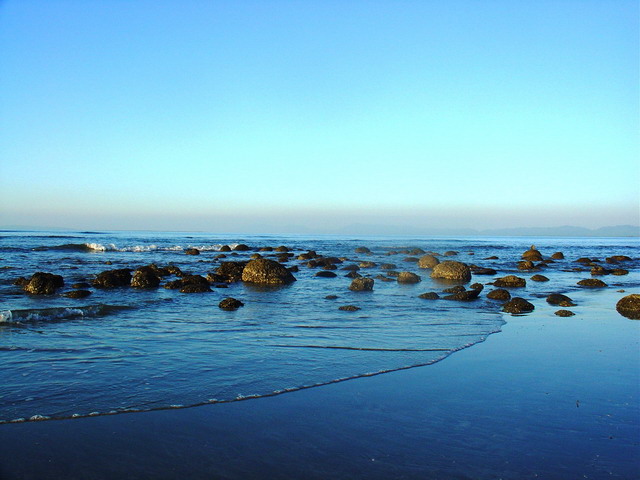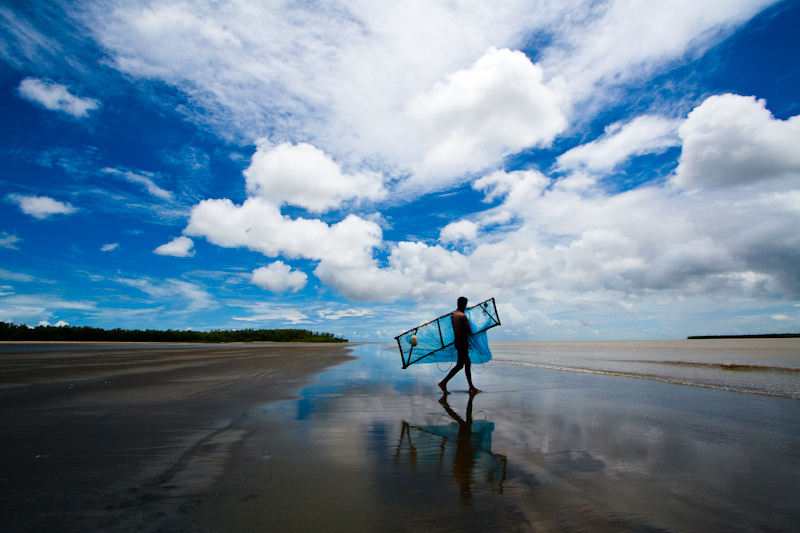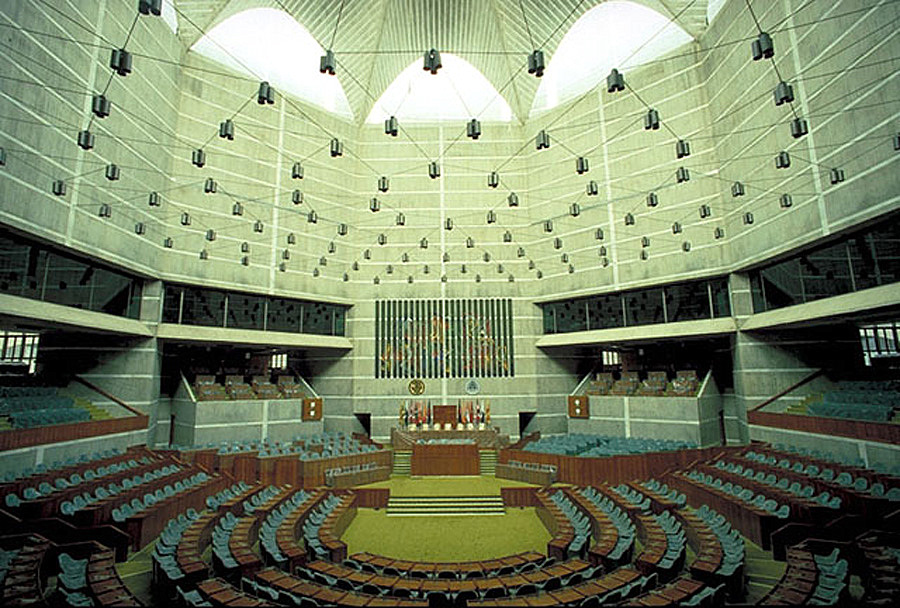 |
| Green Bangladesh |
Bangladesh's tourist attractions include historical monuments, resorts, beaches, picnic spots, forests and tribal people, wildlife of various species. Activities for tourists include angling, water skiing, river cruising, hiking, rowing, yachting, and sea bathing.
Division-wise Tourist attractions
Chittagong division
Cox's Bazar
Cox's Bazar is
known for its wide and long sandy beach, which is considered by many as the
world's longest natural sandy sea beach. This beach is an unbroken 125
kilometers (78 mi) sandy sea beach with a gentle slope.
 |
| Dead corals at St. Martin's Island |
St. Martin's
Island is a small island (area only 8 km2) in the northeastern part
of the Bay of Bengal, about 9 km south of the tip of the Cox's Bazar-Teknaf
peninsula, and forming the southernmost part of Bangladesh. There is a small
adjoining island that is separated at high tide, called Chhera island. It is
about 8 km west of the northwest coast of Myanmar, at the mouth of the Naf
River. The first settlement started just 250 years ago by some Arabian sailors
who named the island 'Zajira'. During British occupation the island was named
St. Martin Island. The local names of the island are "Narical
Gingira", which means 'Coconut Island' in Bengali, and "Daruchini
Dip". It is the only coral island in Bangladesh.
Bandarban
Bandarban is
regarded as one of the most attractive travel destinations in Bangladesh.
Bandarban town is the hometown of the Bohmong Circle Chief (currently King, or
Raja, U Cho Prue Marma) who is the head of the Marma population. It also is the
administrative headquarters of Bandarban district, which has turned into one of
the most exotic tourist attractions in Bangladesh.
Kaptai lake, Shubhalang
waterfall, the hanging bridge and Pablakhali reserve forest are some of the
notable locations to visit in Rangamati.
Khagrachari
Khagrachari is a
district in south-eastern Bangladesh. It is a part of the Chittagong Division
and the Chittagong Hill Tracts. Its local name is "Chengmi". Khagrachari
is also known as Phalang Htaung or the Mong Circle (of the rest of the three
hill districts Rangamati is the Chakma Circle and Bandarban is the Bohmong
Circle). There are many tourist places in Khagrachari like Alutila Cave,
Alutila Tourists spot, Richhang waterfall, Yonged Buddha Bihar, Dighinala
Touduchhori Waterfall and others.
Patenga beach
Patenga is a sea
beach located 14 kilometers south of the port city of Chittagong, Bangladesh.
It is near the mouth of the Karnaphuli River. Patenga is a popular tourist
spot. The beach is very close to the Bangladesh Naval Academy of the Bangladesh
Navy and Shah Amanat International Airport. Its width is narrow and swimming in
the seas is not recommended. Part of the seashore is built-up with concrete walls,
and large blocks of stones have been laid to prevent erosion. During the 1990s,
a host of restaurants and kiosks sprouted out around the beach area. Lighting
of the area has enhanced the security aspect of visiting at night. It is
guarded by large stones to protect it from tsunamis.
A tourist
attraction near Patenga beach is the Butterfly Park.
Foy's Lake
Foy's Lake is a
human-made lake in Chittagong, Bangladesh. The lake was once just a lake and
spillway constructed by Assam-Bengal Railway engineer. It was dug in 1924 and
was named after the English engineer Mr. Foy. The lake is next to Batali Hill,
the highest hill in Chittagong Metropolitan area. An amusement park, managed by
the Concord Group, is located here.
Heritage Park
There is a
heritage park called Shaheed Zia Memorial Complex and Mini Bangladesh at
Chandgaon which reflects the most notable structures and instances of
Bangladesh. This 71-metre tower in Mini Bangladesh in Chittagong has a
restaurant on the top that rotates once every 90 minutes. The museum includes a
revolving restaurant. One can perceive of the country's architectural beauty,
ethnic traditions and archaeological inheritance through having a glimpse of
the heritage park. Replicas of major structures of the country include Jatiya Sangsad
Bhaban (parliament building), National Memorial of Savar, Ahsan Manzil, Curzon
Hall of Dhaka University, Paharpur Monastery, Kantajew Temple of Dinajpur,
Lalbagh Fort and Sona Masjid. The park also has different rides for children.
Ethnological Museum of Chittagong
The Ethnological
Museum of Chittagong located in Agrabad, established in 1965, is the only
ethnological museum in the country, and presents the lifestyles and heritage of
various ethnic groups of the country. The museum authority collected rare
elements used in everyday lives of different ethnic groups, of which some had
already become extinct while others were on the verge of extinction. The museum
contains four galleries and a small hall. Three galleries of the museum feature
diverse elements of twenty nine ethnic groups in Bangladesh, while the rest of
the gallery displays the lifestyles of some ethnic groups of India, Pakistan
and Australia.
WWII cemetery
The War Cemetery
on Badshah Mia Road contains the graves of 755 soldiers, and is protected and
maintained by the Commonwealth War Graves Commission. There are also a number
of museums in Chittagong.
Sylhet Division
Bichnakandi
Bichnakandi is a
village in Rustompur Union in Gowainghat Upazila of Sylhet District. In recent
years there has been an influx of tourists to its river.
Jaflong
Jaflong is a
hill station and popular tourist destination in the Division of Sylhet,
Bangladesh. It is located in Gowainghat Upazila of Sylhet District and situated
at the border between Bangladesh and the Indian state of Meghalaya,
overshadowed by subtropical mountains and rainforests. Jaflong is famous for
its stone collections and is home of the Khasia tribe.
Ratargul Swamp Forest
Ratargul Swamp
Forest is a freshwater swamp forest located in Gowainghat, Sylhet. It is the
only swamp forest located in Bangladesh and one of the few freshwater swamp
forests in the world. The forest is naturally conserved under the Department of
Forestry, Govt. of Bangladesh.
 |
| Ratargul Swamp Forest |
The evergreen
forest is situated by the river Goain and linked with the channel Chengir Khal.
Most of the trees growing here are the Millettia pinnata ("Koroch
tree"). The forest is submerged under 20–30 feet water in the rainy
season. For the rest of the year, the water level is about 10 feet deep.
Madhobpur Lake
Madhobpur Lake
is a lake of Srimangal in Maulvi Bazar District of Bangladesh. It is one of the
popular tourist spots in Bangladesh.
Tea Garden
There are
numbers of tea gardens in Sylhet, Moulovibazar and Hobiganj districts in Sylhet
Division. Srimangal upozila of Moulovibazar is called the capital of tea.
The wonderful scenery of tea garden attracts every tourist of any age.
Haors
A big number of
haors are located in Sylhet Division as well as some other districts. Largest
Tangua haor & Hakaluki haor and almost every haor is enjoyable a lot.
Dhaka division
Dhaka Division
is an administrative division in Bangladesh. Dhaka is the largest and capital
city of Bangladesh.
Lalbagh Fort
Lalbagh Fort is
an incomplete 17th century Mughal fort complex in Dhaka, Bangladesh. This fort
(also known as Fort Aurangabad) stands proudly before the Buriganga River in
the southwestern part of Dhaka, Bangladesh. The construction was started in
1678 AD by Mughal Subahdar Muhammad Azam Shah. For long the fort was considered
to be a combination of three buildings (the mosque, the tomb of Bibi Pari and
the Diwan-i-Aam), with two gateways and a portion of the partly damaged fortification
wall. Recent excavations carried out by the Department of Archaeology have
revealed the existence of other structures.
Ahsan Manzil is
a wonderful ancient building, located on the bank of the river Buriganga, in
old Dhaka at Kumartoli, Islampur area. It was a residential palace for Dhaka
Nawab Family. The structure of this palace was started in the year 1859 and was
finished in 1869. It is constructed in the Indo-Saracenic Revival architecture.
To preserve the cultural and history of the area, the palace became the
Bangladesh National Museum on 20 September 1992.
Shaheed Minar
The Shaheed Minar (English: Martyr Monument)
is a national monument in Dhaka, Bangladesh, established to commemorate those
killed during the Bengali Language Movement demonstrations of 1952. On 21
February 1952, dozens of students and political activists were killed when the
Pakistani police force opened fire on Bengali protesters who were demanding
equal status for their native tongue, Bengali. The massacre occurred near Dhaka
Medical College and Ramna Park in Dhaka. A makeshift monument was erected on 23
February by students of University of Dhaka and other educational institutions,
but demolished on 26 February by the Pakistani police force. The Language
Movement gained momentum, and after a long struggle, Bengali was given equal
status with Urdu. To commemorate the dead, the Shaheed Minar was designed and
built by Hamidur Rahman, a Bangladeshi sculptor. The monument stood until the
Bangladesh Liberation War in 1971, when it was demolished completely during
Operation Searchlight. After Bangladesh gained independence, it was rebuilt. At
present, all national, mourning, cultural and other activities held each year,
regarding 21 February, have been centred around the Shaheed Minar.
Jatiyo Smriti Soudho
Jatiyo Sriti
Shoudho or National Martyrs' Memorial is
the national monument of Bangladesh is the symbol in the memory of the valour
and the sacrifice of all those who gave their lives in the Bangladesh
Liberation War of 1971.
Jatiya Sangshad
Jatiyo Sangsad
Bhaban (English: National Parliament) was created by American architect Louis
Kahn. Construction was started in 1961 and completed on 28 January 1982 with
the total cost was about 32 million dollars. It is situated at Shre-e-Bangla
Nagar in Dhaka. Jatiyo Sangsad Bhaban was used for the first time on 15
February 1982 as the venue for the eighth (last) session of the second
parliament of Bangladesh. Since then, it has been used for the Bangladesh
National Assembly.
Tourist
attractions in Dhaka
- Lalbagh Fort
- Dhakeshwari Temple
- Baitul Mukarram
- Ahsan Manzil
- Shaheed Minar
- Liberation War Museum
- Rickshaw art and rickshaw-riding
- Jatiyo Sangsad Bhaban
- Bashundhara City; etc
Rajshahi and Rangpur Division
Shiva Temple in Puthia, Rajshahi
A wonderful
Shiva Temple was constructed in Puthia Rajbari, Puthiya, Rajshahi.
Somapura Mahavihara
Somapura
Mahavihara in Paharpur, Naogaon District is among the best known Buddhist
viharas in the Indian Subcontinent and is one of the most important
archaeological sites in the country. It was designated a UNESCO World Heritage
Site in 1985.
Mahastangar
Mahasthangarh is
one of the earliest urban archaeological sites so far discovered in Bangladesh.
The village Mahasthan in Bogra District contains the remains of an ancient city
which was called Pundranagara or Paundravardhanapura in the territory of
Pundravardhana. A limestone slab bearing six lines in Prakrit in Brahmi script,
discovered in 1931, dates Mahasthangarh to at least the 3rd century BC. The
fortified area was in use till the 18th century AD.
Behula Lakshindar Basor Ghor at Bogra
Behula is the
protagonist in the Manasamangal genre of Bengali medieval epics. A number of
works belonging to this genre were written between the thirteenth and eighteenth
centuries. Though the religious purpose of these works is to eulogise the Hindu
goddess Manasa, these works are more well known for depicting the love story of
Behula and her husband Lakhindar.
Kantajew Temple
Kantajew Temple
is a late-medieval Hindu temple in Dinajpur, Bangladesh. Built by Maharaja Pran
Nath, its construction started in 1704 CE and ended in the reign of his son
Raja Ramnath 1722 CE. It is regarded as one of the greatest examples on
Terracotta architecture in Bangladesh and once had nine spires, but all were
destroyed during the 1897 Assam earthquake.
Varendra Research Museum
Varendra Museum
is a museum, research centre and visitor attraction in Rajshahi town and
maintained by the University of Rajshahi.
Bagha Mosque
According to an
inscription on the mosque's central entrance, bagha Mosque was Built by Sultan
Nusrat Shah in 1523. Bagha Mosque is a richly decorated monument originally
roofed over with ten domes which collapsed long ago. It is built of bricks with
stone plinth, lintels and pillars. Recently this mosque was rebuilt carefully
to its original form.
Barisal Division
Kuakata beach
 |
Kuakata beach |
Khulna Division
Sundarbans
The Sundarbans is the largest single block of tidal halophytic mangrove forest in the world. The
.jpg) |
| Chital deer |
Mosque City of Bagerhat
The Mosque City
of Bagerhat is a formerly lost city, located in the suburbs of Bagerhat city in
Bagerhat District, in the Khulna Division.
Originally known
as Khalifatabad and nicknamed the "mint town of the Bengal
Sultanate", the city was founded in the 15th century by the warrior saint
Turkish general Ulugh Khan Jahan.
| Sixty Dome Mosque in Bagerhat |
Courtesy: Wikipedia
This work is licensed under a Creative Commons Attribution-ShareAlike 3.0 Unported License.










.jpg)

0 Comments:
Post a Comment